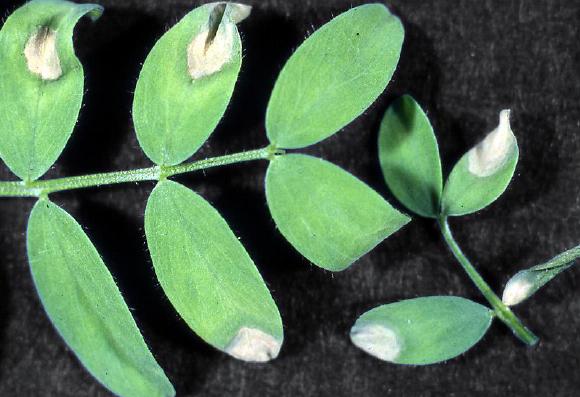Symptoms
First seen as green-white lesions on leaves, which become tan-coloured lesions of variable size as the plant matures, followed by premature leaf drop. Lesions on stems develop soon after the appearance of leaf lesions. Stem lesions may be either small, brownish with a black border, or larger, stretching along the stem. As lesions age, small, black microsclerotia (small, pinhead-sized structures) are formed within the lesions. As the crop grows, more and more lesions develop at the base of the plant, as well as on the upper part of the stems, and many stems can become completely girdled. As a result, large areas of brown and dying plants can be found in the field.
Organism
Colletotrichum truncatum (lentil infecting strains).
Host range
The lentil infecting form of Colletotrichum truncatum only attacks plant species belonging to the Lens and Vicia families. In Australia the
pathogen has been found on peanut and soybean, but the lentil infecting form is considered exotic. Colletotrichum truncatum has a very broad host range including peanut, soybean, lentil, field pea, subterranean clover, vetches, faba bean and Stylosanthes spp. But this pathogen is known to have ‘pathotypes’ that only attack some species.
Method of spread
Anthracnose-infected debris from previous lentil crops is the main source of inoculum, however it can be seed-borne at low levels. In addition, the fungus survives as microsclerotia, which continue to survive in the soil for some time, at least five years or more, even in the absence of the host and initiate new infections.
The pathogen will survive over summer in infected seed, infected trash, and as microsclerotia in the soil. Spores are spread via rain splash onto
surrounding seedlings. Spores are produced in large numbers on infected seedlings that spread the disease further onto surrounding plants.
Conditions favouring disease
Anthracnose spores infect lentil readily at 20-24°C and require 18-24 hours of leaf wetness.
Confused with?
Symptoms of the disease are very similar to Ascochyta blight and may require trained pathologists to distinguish the diseases. Microsclerotia are very distinct compared to the pycidia (small, black fruiting bodies) produced by ascochyta. The microsclerotia tend to be larger and raised within the lesion.
Where?
North America, Europe, Middle East and Pakistan. The disease is known to be most destructive in North America on lentil. The lentil-infecting form of C. truncatum is exotic to Australia.

Image 6. Stem lesions on lentils in the field.
Source: Kurt Lindbeck, NSW Department of Primary Industries.

Image 7. Leaf lesions on lentils.
Source: Kurt Lindbeck, NSW Department of Primary


